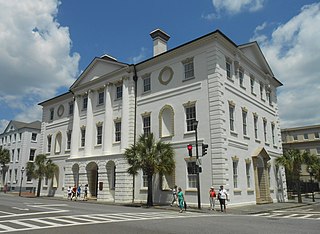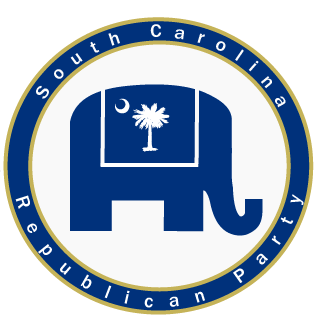The Conservative Party of South Carolina was a political party of South Carolina during Reconstruction. It was founded in 1874 by James Chestnut from the State Tax Union to provide an organization for the mobilization of white voters. The absence of an active and statewide Democratic Party led many Democrats to become members of the Conservative Party for the election of 1874. The reemergence of a strong Democratic Party for the election of 1876 ended the Conservative Party.

South Carolina is a state in the Southeastern United States and the easternmost of the Deep South. It is bordered to the north by North Carolina, to the southeast by the Atlantic Ocean, and to the southwest by Georgia across the Savannah River.

The Democratic Party is one of the two major contemporary political parties in the United States, along with the Republican Party. Tracing its heritage back to Thomas Jefferson and James Madison's Democratic-Republican Party, the modern-day Democratic Party was founded around 1828 by supporters of Andrew Jackson, making it the world's oldest active political party.
A convention in Columbia for the State Tax Union was summoned for September 10, 1874, by James Chestnut. The purpose of the convention was to plan for the election of 1874 and to dispute a statement by President Grant on September 2 about the recent activities of the Ku Klux Klan (KKK) in the South.

Columbia is the capital and second largest city of the U.S. state of South Carolina, with a population estimate of 134,309 as of 2016. The city serves as the county seat of Richland County, and a portion of the city extends into neighboring Lexington County. It is the center of the Columbia metropolitan statistical area, which had a population of 767,598 as of the 2010 United States Census, growing to 817,488 by July 1, 2016, according to 2015 U.S. Census estimates. The name Columbia is a poetic term used for the United States, originating from the name of Christopher Columbus.

Ulysses S. Grant was an American politician, soldier, international statesman, and author, who served as the 18th president of the United States from 1869 to 1877. During the American Civil War Grant led the Union Army as its commanding general to victory over the Confederacy with the supervision of President Abraham Lincoln. During the Reconstruction Era, President Grant led the Republicans in their efforts to remove the vestiges of Confederate nationalism, racism, and slavery.

The Ku Klux Klan, commonly called the KKK or the Klan, is an American white supremacist hate group. The Klan has existed in three distinct eras at different points in time during the history of the United States. Each has advocated extremist reactionary positions such as white nationalism, anti-immigration and—especially in later iterations—Nordicism and anti-Catholicism. Historically, the Klan used terrorism—both physical assault and murder—against groups or individuals whom they opposed. All three movements have called for the "purification" of American society and all are considered right-wing extremist organizations. In each era, membership was secret and estimates of the total were highly exaggerated by both friends and enemies.
Chestnut called for another convention of the State Tax Union to be held on October 8 in Columbia to discuss election strategies and choose candidates for office. The delegates agreed to support the Independent Republican statewide ticket and adopted a platform of honesty and efficiency in state government.
The Independent Republican Party of South Carolina was a political party of South Carolina during Reconstruction. It was founded in 1872 to oppose the election of Franklin J. Moses Jr. for Governor of South Carolina after he had been nominated by the Republicans on August 21, 1872. Former Governor James Lawrence Orr denounced the selection of Moses and led the formation of a new party.
The Independent Republican statewide candidates were all defeated for the general election on November 3, 1874. However, the Conservatives did reduce the majorities of the Republicans in the House and the Senate, albeit modestly. A fusion of the Conservative and Independent Republican parties in Charleston County enabled Conservatives to be elected to the General Assembly from Charleston and for the Independent Republican Edmund W.M. Mackey to win a seat in Congress from the Second District.

The South Carolina House of Representatives is the lower house of the South Carolina General Assembly, the upper house being the South Carolina Senate. It consists of 124 Representatives elected to two year terms at the same time as US Congressional elections.

The South Carolina Senate is the upper house of the South Carolina General Assembly, the lower house being the South Carolina House of Representatives. It consists of 46 senators elected from single member districts for four-year terms at the same time as United States Presidential elections.

Charleston County is located in the U.S. state of South Carolina along the Atlantic coast. As of the 2010 census, its population was 350,209, making it the third most populous county in South Carolina. Its county seat is Charleston. The county was created in 1901 by an act of the South Carolina State Legislature.
While unable to achieve its electoral goals in the election, the lasting effect of the Conservative Party was to provide a basis for the reformation of the Democratic Party. The failure of the Conservatives caused the Democrats to believe that in order to gain control of state government, they needed to nominate a full slate of statewide candidates for the election of 1876.









